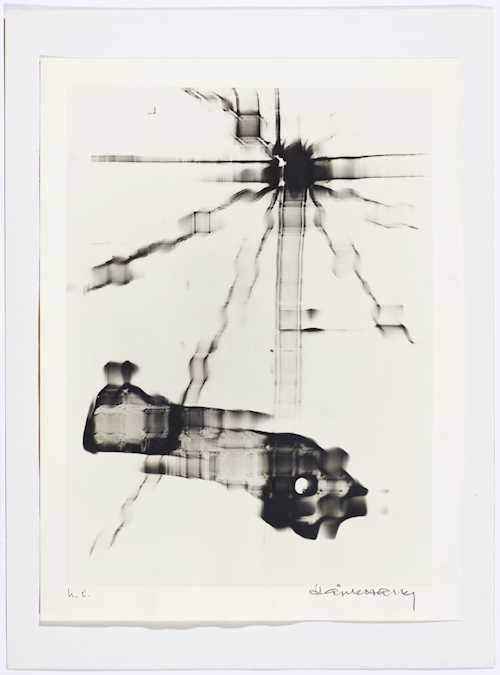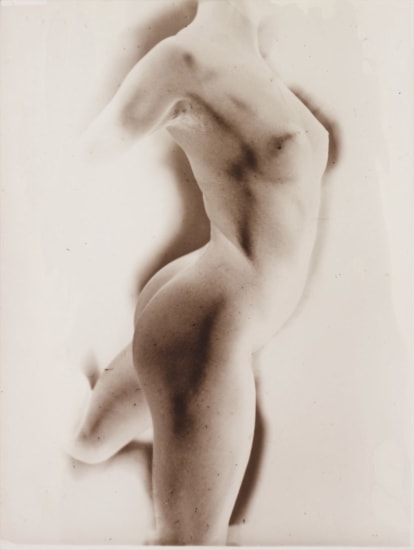Heinz Hajek-Halke Der Gong 1960 Gelatin silver print. 37.8 x 28.7 cm (14 7/8 x 11 5/16 in). Signed and dated in ink and credit stamp on the verso.
Provenance Private Collection, Europe Literature Subjective photography: The German contribution 1948-1963, exh. cat., Institut für Auslandsbeziehungen, Stuttgart, 1989, p. 42; Heinz Hajek-Halke Fotografie, Foto-Grafik, Licht-Grafik, exh. cat., Galerie Werner Kunze, Berlin, p. 29 Catalogue Essay SUBJECTIVE PHOTOGRAPHY (Lots 170 - 188) The late 1940s and early 1950s, the years following World War II, was the time of new beginnings. An international movement in photography that drew upon the principles of the pre-war avant- garde was also growing a significant reputation during this era. Its goals: to go beyond the mimetic representation of the visible and to create creative, artistic images by purely photographic means and experimental techniques. Abstract shapes and graphic structures, black-and-white contrasts, and radical cropping emphasised the primacy of pictorial photography and pursued the goal of achieving a self-contained and autonomous image. The movement, which came together between circa 1948 and 1963, included members from Germany and France, the Netherlands and Sweden, Italy and England. They displayed their works in 1951, 1954/55 and 1958 in three extensive exhibitions titled subjektive fotografie (subjective photography). Each exhibition comprised several international stations: a selection from the first show, for example, was shown not only in Cologne and Munich but also in the George Eastman House in Rochester, NY. The subsequent shows were on view in Paris (1955) and Tokyo (1956), among other cities. It was German photographer Otto Steinert the instructor of artistic photography at the Staatliche Schule für Kunst und Handwerk (State School for Art and Crafts) in Saarbrücken and from 1959 at the renowned Folkwangschule für Gestaltung in Essen, who concentrated the various efforts and originated the title subjektive fotografie under which the creative photographic minds could converge. Steinert stated that the name stands for "the creative impulse of the individual photographer, in contradistinction to ‘applied’ utilitarian and documentary photography." Steinert’s goal was nothing short of forming "the visual consciousness of our time; a contribution to the creative development of the international language of photography." Members of the group drew explicitly from the work of pre-war avant-garde artists such as László Moholy-Nagy Man Ray, and Herbert Beyer, whose works were also displayed in the 1951 subjective photography exhibition in Saarbrücken. The international photographic visual language that Steinert posited naturally also encompassed simultaneous developments in America; examples include the works by Harry Callahan and Aaron Siskind at the Chicago Institute of Design, which Moholy-Nagy founded as the "New Bauhaus" in 1937, and Minor White a significant teacher and publisher of Aperture magazine (founded in 1952 and still running today). Callahan and White – as well as William Klein and Irving Penn – were shown with other American photographers alongside their European counterparts in the second subjective photography exhibition in 1954/55. The current selection of works by Heinz Hajek-Halke Siegfried Lauterwasser and Toni Schneiders represents a collection from the German group fotoform, which was at the forefront of the subjective movement. Hajek-Halke maximized experimental potential in an incomparable manner, from the carefully staged table-top photos to the macro-perspective images of imaginative fairy-tale figures (in fact, various liquids pressed between glass plates). Sandwich or photomontage techniques (such as those of Siegfried Lauterwasser) and long exposures (such as in the works of Wolf Strache and the photograms of Dutch artist Pim van Os) are the trademarks of subjective photography’s artistic expression. Wolf Strache long-time publisher of the annual Deutsche Lichtbild, employed the principles of subjective photography in his 1953 book Schöpferische Kamera even though he had no
Heinz Hajek-Halke Der Gong 1960 Gelatin silver print. 37.8 x 28.7 cm (14 7/8 x 11 5/16 in). Signed and dated in ink and credit stamp on the verso.
Provenance Private Collection, Europe Literature Subjective photography: The German contribution 1948-1963, exh. cat., Institut für Auslandsbeziehungen, Stuttgart, 1989, p. 42; Heinz Hajek-Halke Fotografie, Foto-Grafik, Licht-Grafik, exh. cat., Galerie Werner Kunze, Berlin, p. 29 Catalogue Essay SUBJECTIVE PHOTOGRAPHY (Lots 170 - 188) The late 1940s and early 1950s, the years following World War II, was the time of new beginnings. An international movement in photography that drew upon the principles of the pre-war avant- garde was also growing a significant reputation during this era. Its goals: to go beyond the mimetic representation of the visible and to create creative, artistic images by purely photographic means and experimental techniques. Abstract shapes and graphic structures, black-and-white contrasts, and radical cropping emphasised the primacy of pictorial photography and pursued the goal of achieving a self-contained and autonomous image. The movement, which came together between circa 1948 and 1963, included members from Germany and France, the Netherlands and Sweden, Italy and England. They displayed their works in 1951, 1954/55 and 1958 in three extensive exhibitions titled subjektive fotografie (subjective photography). Each exhibition comprised several international stations: a selection from the first show, for example, was shown not only in Cologne and Munich but also in the George Eastman House in Rochester, NY. The subsequent shows were on view in Paris (1955) and Tokyo (1956), among other cities. It was German photographer Otto Steinert the instructor of artistic photography at the Staatliche Schule für Kunst und Handwerk (State School for Art and Crafts) in Saarbrücken and from 1959 at the renowned Folkwangschule für Gestaltung in Essen, who concentrated the various efforts and originated the title subjektive fotografie under which the creative photographic minds could converge. Steinert stated that the name stands for "the creative impulse of the individual photographer, in contradistinction to ‘applied’ utilitarian and documentary photography." Steinert’s goal was nothing short of forming "the visual consciousness of our time; a contribution to the creative development of the international language of photography." Members of the group drew explicitly from the work of pre-war avant-garde artists such as László Moholy-Nagy Man Ray, and Herbert Beyer, whose works were also displayed in the 1951 subjective photography exhibition in Saarbrücken. The international photographic visual language that Steinert posited naturally also encompassed simultaneous developments in America; examples include the works by Harry Callahan and Aaron Siskind at the Chicago Institute of Design, which Moholy-Nagy founded as the "New Bauhaus" in 1937, and Minor White a significant teacher and publisher of Aperture magazine (founded in 1952 and still running today). Callahan and White – as well as William Klein and Irving Penn – were shown with other American photographers alongside their European counterparts in the second subjective photography exhibition in 1954/55. The current selection of works by Heinz Hajek-Halke Siegfried Lauterwasser and Toni Schneiders represents a collection from the German group fotoform, which was at the forefront of the subjective movement. Hajek-Halke maximized experimental potential in an incomparable manner, from the carefully staged table-top photos to the macro-perspective images of imaginative fairy-tale figures (in fact, various liquids pressed between glass plates). Sandwich or photomontage techniques (such as those of Siegfried Lauterwasser) and long exposures (such as in the works of Wolf Strache and the photograms of Dutch artist Pim van Os) are the trademarks of subjective photography’s artistic expression. Wolf Strache long-time publisher of the annual Deutsche Lichtbild, employed the principles of subjective photography in his 1953 book Schöpferische Kamera even though he had no







Try LotSearch and its premium features for 7 days - without any costs!
Be notified automatically about new items in upcoming auctions.
Create an alert